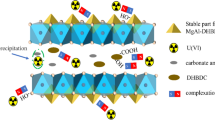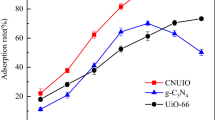Abstract
In this work, pure gadolinium oxide (Gd2O3) and mixed gadolinium oxide (Gd2O3)–magnesium oxide (MgO) composites were synthesized by simple hydrothermal method and calcination treatment. Two kinds of materials were used to remove uranyl ions from aqueous solution and characterized the structure and morphology by means of XRD, FT-IR, SEM, EDS and XPS. MgO was introduced into Gd2O3 material, which effectively avoided the agglomeration of Gd2O3 material and increased the adsorption capacity. The effects of different initial pH, initial uranium concentration and contact time on the adsorption performance of UO22+ were investigated by static adsorption experiments. At 25 °C, the maximum adsorption capacities of Gd2O3 and Gd2O3–MgO for UO22+ were 473.43 mg·g−1 and 812.41 mg·g−1, respectively. The adsorption process was fitted well with the Langmuir isotherm model and pseudo-second-order kinetic model. The thermodynamic fitting parameters (ΔG < 0, ΔS > 0 and ΔH > 0) indicated that the adsorption properties are endothermic and spontaneous. Gd2O3–MgO has a relatively large specific surface area and high adsorption capacity, but its stability and regeneration ability are reduced after three times of reuse. The possible adsorption mechanism is derived from XPS and FT-IR analysis, which mainly involves the complexation of –OH and U(VI) generated by the hydration on the surface of the materials.















Similar content being viewed by others
Availability of data and materials
Not applicable.
Code availability
Not applicable.
References
Abu-Dief AM, Essawy AA, Diab AK et al (2020) Facile synthesis and characterization of novel Gd2O3/CdO binary mixed oxide nanocomposites of highly photocatalytic activity for wastewater remediation under solar lumination. J Phys Chem Solids 148:109666
Ashrafi F, Firouzzare M, Ahmadi SJ et al (2019) Preparation and modification of forcespun polypropylene nanofibers for adsorption of uranium (VI) from simulated seawater. Ecotoxicol Environ Saf 186:109746
Bayramoglu G, Yakup M (2016) MCM-41 silica particles grafted with polyacrylonitrile: modification in to amidoxime and carboxyl groups for enhanced uranium removal from aqueous medium. Microporous and Mesoporous Mater 226:117–124
Chowdhury AH, Chowdhury IH, Naskar MK et al (2015) A facile synthesis of grainy rod-like porous MgO. Mater Lett 158:190–193
Chowdhury IH, Chowdhury AH, Bose P et al (2016) Effect of anion type on the synthesis of mesoporous nanostructured MgO, and its excellent adsorption capacity for the removal of toxic heavy metal ions from water. RSC Adv 6(8):6038–6047
Dhananjaya N, Bhushana N, Sharma S et al (2014) Hydrothermal synthesis of Gd2O3:Eu3+ nanophosphors: effect of surfactant on structural and luminescence properties. J Alloy Compd 587:755–762
Fei H, Liu X, Li Z et al (2015) Synthesis of manganese coordination polymer microspheres for lithium-ion batteries with good cycling performance. Electrochim Acta 174:1088–1095
Han Y, Zhang S, Shen Na et al (2016) MOF-derived porous NiO nanoparticle architecture for high performance supercapacitors. Mater Lett 188:1–4
Hu B, Wang H, Liu R et al (2021) Highly efficient U(VI) capture by amidoxime/carbon nitride composites: Evidence of EXAFS and modeling. Chemosphere 274:129743
Huang Z, Wang N, Li X et al (2020) Calcination of layered double hydroxide membrane with enhanced nanofiltration performance. J Ind Eng Chem 89:368–374
Ilton ES, Bagus PS (2011) XPS determination of uranium oxidations states. Surface Interface Anal 43(13):275–286
Juibari NM, Tarighi S (2020) Metal–organic framework-derived nanocomposite metal-oxides with enhanced catalytic performance in thermal decomposition of ammonium perchlorate. J Alloys Compd 832:154837
Kaur R, Kaur A, Umar A et al (2019) Metal organic framework (MOF) porous octahedral nanocrystals of Cu-BTC: Synthesis, properties and enhanced adsorption properties. Mater Res Bull 109(1):124–133
Li W, Chen D, **a F et al (2015) Extremely high arsenic removal capacity for mesoporous aluminium magnesium oxide composites. Environmental Ence Nano 3(1):94–106
Li Y, Yuxia Xu, Yang W et al (2018) MOF-derived metal oxide composites for advanced electrochemical energy storage. Small 14(25):1704435
Li M, Liu H, Chen T et al (2020) Effificient U(VI) adsorption on iron/carbon composites derived from the coupling of cellulose with iron oxides: performance and mechanism. Sci Total Environ 703:135604
Lin M-C, Chang F-T, Uan J-Y et al (2013) Aqueous Li+/Al3+ alkaline solution for CO2 capture and the massive Li-Al-CO3 hydrotalcite precipitation during the interaction between CO2 gas and the Li+/Al3+ aqueous solution. J Mater Chem 46:14773–14782
Linghu W, Yang H, Sun Y et al (2017) One-pot synthesis of LDH/GO composites as highly effective adsorbents for decontamination of U(IV). ACS Sustain Chem Eng 5:5608–5616
Liu Yu, Hui Xu (2007) Equilibrium, thermodynamics and mechanisms of Ni2+ biosorption by aerobic granules. Biochem Eng J 35(2):174–182
Liu S, Luo M, Li J et al (2016) Adsorption equilibrium and kinetics of uranium onto porous azo-metal-organic frameworks. J Radioanal Nucl Chem 310:1–10
Liu N, Wang J, **xing W et al (2020a) Magnetic Fe3O4@MIL-53(Fe) nanocomposites derived from MIL-53(Fe) for the photocatalytic degradation of ibuprofen under visible light irradiation-Science Direct. Mater Res Bull 132:111000
Liu P, Qiang Yu, Xue Y et al (2020b) Adsorption performance of U(VI) by amidoxime-based activated carbon. J Radioanal Nucl Chem 324:813–822
Luo B-C, Yuan L-Y, Chai Z-F et al (2016) U(VI) capture from aqueous solution by highly porous and stable MOFs: UiO-66 and its amine derivative. J Radioanal Nucl Chem 307(1):269–276
Milmile SN, Pande JV, Karmakar S et al (2011) Equilibrium isotherm and kinetic modeling of the adsorption of nitrates by anion exchange Indion NSSR resin. Desalination 276(1–3):38–44
Molavi H, Eskandari A, Shojaei A et al (2018) Enhancing CO2/N2 adsorption selectivity via post-synthetic modification of NH2-UiO-66 (Zr). Microporous Mesoporous Mater 257:193–201
Oladoja NA, Chen S, Drewes JE et al (2015) Characterization of granular matrix supported nano magnesium oxide as an adsorbent for defluoridation of groundwater. Chem Eng J 281(3):632–643
Peng W, Huang G, Yang S et al (2019) Performance of biopolymer/graphene oxide gels for the effective adsorption of U(VI) from aqueous solution. J Radioanal Nucl Chem 322:861–868
Qiu L-G, Li Z-Q, Yun Wu et al (2008) Facile synthesis of nanocrystals of a microporous metal–organic framework by an ultrasonic method and selective sensing of orgaoamines. Chem Commun 31:3642–3644
Rajaei A, Ghani K, Jafari M (2021) Modification of UiO-66 for removal of uranyl ion from aqueous solution by immobilization of tributyl phosphate. J Chem Sci 133(1):14
Riella HG, Durazzo M, Hirata M et al (1991) UO2-Gd2O3 solid solution formation from wet and dry processes. J Nucl Mater 178(2–3):204–211
Shahbazi A, Younesi H, Badiei A (2011) Functionalized SBA-15 mesoporous silica by melamine-based dendrimer amines for adsorptive characteristics of Pb(II), Cu(II) and Cd(II) heavy metal ions in batch and fixed bed column. Chem Eng J 168(2):505–518
Shao D, Ren X, Wen J et al (2016) Immobilization of uranium by biomaterial stabilized FeS nanoparticles: effects of stabilizer and enrichment mechanism. J Hazard Mater 302:1–9
Song F, Zhang Z, Mai X et al (2021) Efficient removal of U(VI) from aqueous solutions via an activated 3D framework carbon. J Radioanal Nucl Chem 327(2):721–729
Syrbu N, Zalamai V, Culeac I et al (2019) Optical activity induced by rare-earth ions in As2S3 glasses and KCl crystals. Opt Laser Technol 114:216–223
Tamrakar RK, Bisen DP (2015) Thermoluminescence studies of ultraviolet and gamma irradiated erbium(III)-and ytterbium(III)-doped gadolinium oxide phosphors. Mater Sci Semicond Process 33:169–188
Tarighi S, Abbasi A, Geranmayeh S et al (2013) Synthesis of a new interpenetrated mixed ligand Ni(II) metal organic framework: structural, thermal and fluorescence studies and its thermal decomposition to NiO nanoparticles. J Inorg Organomet Polym Mater 23(4):808–815
Wang X, Le L, Alvarez PJJ et al (2015) Synthesis and characterization of green agents coated Pd/Fe bimetallic nanoparticles. J Taiwan Inst Chem Eng 50:297–305
Wang F, Li H, Liu Qi et al (2016a) A graphene oxide/amidoxime hydrogel for enhanced uranium capture. Sci Rep 6:19367
Wang X, Fan Q, Shujun Yu et al (2016b) High sorption of U(VI) on graphene oxides studied by batch experimental and theoretical calculations. Chem Eng J 287:448–455
Wang Y, Chen Y, Fang Yu et al (2017) The effect of magnesium oxide morphology on adsorption of U(VI) from aqueous solution. Chem Eng J 316:936–950
Wang Y, Chen Y, Liu C et al (2018) High-efficiency enrichment of uranium(VI) from aqueous solution by hydromagnesite and its calcination products. J Radioanal Nucl Chem 315:171–183
Wang D, Xu Y, **ao D et al (2019) Ultra-thin iron phosphate nanosheets for high efficient U(VI) adsorption. J Hazardous Mater 371:83–93
Wang J, Fang F, Zhou Y et al (2020a) Facile modification of graphene oxide and its application for the aqueous uranyl ion sequestration: Insights on the mechanism. Chemosphere 258:127152
Wang X, Guo H, Wang F et al (2020b) Halloysite nanotubes: an eco-friendly adsorbent for the adsorption of Th(IV)/U(VI) ions from aqueous solution. J Radioanal Nucl Chem 324:1151–1165
Wang Z, Liu Z, Ye T et al (2020c) Removal of uranyl ions from aqueous media by tannic acid-chitosan hydrothermal carbon: equilibria, kinetics and thermodynamics. J Radioanal Nucl Chem 326:1843–1852
**e X, Wang Y, **ong Z et al (2020) Highly efficient removal of uranium(VI) from aqueous solution using poly(cyclotriphosphazene-co-polyethyleneimine) microspheres. J Radioanal Nucl Chem 326(3):1867–1877
Xu C, Zhang W, Chen Y et al (2019) Synthesis of NH2-MIL-125/NH2 -MIL-125-P@TiO2 and Its Adsorption to Uranyl Ions. Chem Select. 43(04):12801–12806
Yang H, Luo X, Ding H et al (2019) Adsorption of U(VI) by Elodea nuttallii: equilibrium, kinetic and mechanism analysis. J Radioanal Nucl Chem 319:227–235
Yao N, Fan Z, Meng R et al (2020) A cobalt hydroxide coated metal-organic framework for enhanced water oxidation electrocatalysis. Chem Eng J 408:127319
Zhang S, Ying Lu, Lin X et al (2014) Removal of fluoride from groundwater by adsorption onto La(III)-Al(III) loaded scoria adsorbent. Appl Surf Sci 303:1–5
Zhang B, Sun HY, Li J et al (2019) Fast and selective removal of aqueous uranium by a K+-activated robust zeolitic sulfde with wide pH resistance. Inorg Chem 58(17):11622–11629
Zhao C, Liu J, Deng Y et al (2019) Uranium(VI) adsorption from aqueous solutions by microorganism-graphene oxide composites via an immobilization approach. J Clean Product 236:117624
Acknowledgements
Thanks to the National Natural Science Foundation for its support.
Funding
The work was supported by the National Natural Science Foundation of China (21667024).
Author information
Authors and Affiliations
Contributions
All authors contributed to the concept and design of the study. Lili Zhang was involved in preparation and completion of experiments, data analysis, manuscript preparation and writing; Yuantao Chen* contributed to methodological analysis; Meng Zhao was involved in experiment preparation; Wang Yinghui contributed to review of the original draft.
Corresponding author
Ethics declarations
Conflict of interest
The authors declare that they have no conflict of interest.
Ethics approval
Not applicable.
Consent to participate
Not applicable.
Consent for publication
All authors have consented to this content and have expressly consented to its publication.
Additional information
Editorial responsibility: Fatih ŞEN.
Rights and permissions
About this article
Cite this article
Zhang, L., Chen, Y., Zhao, M. et al. Efficient adsorption of uranyl ions from aqueous solution by Gd2O3 and Gd2O3–MgO composite materials. Int. J. Environ. Sci. Technol. 20, 815–830 (2023). https://doi.org/10.1007/s13762-022-04001-5
Received:
Revised:
Accepted:
Published:
Issue Date:
DOI: https://doi.org/10.1007/s13762-022-04001-5




